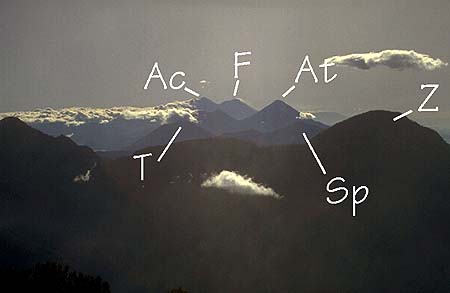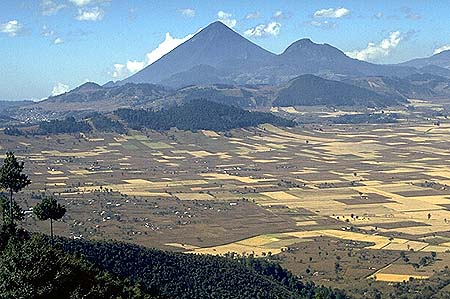
Strato Volcanoes comprise the largest percentage (~60%) of the Earth's individual volcanoes and most are characterized by eruptions of andesite and dacite - lavas that are cooler and more viscous than basalt. These more viscous lavas allow gas pressures to build up to high levels (they are effective "plugs" in the plumbing), therefore these volcanoes often suffer explosive eruptions. Strato volcanoes are usually about half-half lava and pyroclastic material, and the layering of these products gives them their other common name of composite volcanoes. The lava at strato volcanoes occasionally forms 'a'a, but more commonly it barely flows at all, preferring to pile up in the vent to form volcanic domes.
Left: Here is a nice family of Guatemalan strato volcanoes. This view is towards the East from the summit of Santa Maria Volcano, and the volcanoes are Acatenango (Ac), Fuego (F), Atitlan (At), Zunil (Z), San Pedro (Sp), and Toliman (T).

This is a schematic diagram of a strato volcano, intended to illustrate the different layers of different materials that comprise them. The purple colors are meant to represent ash layers, either the products of fall-out from big eruption clouds or the products of pyroclastic flows. Notice that these ash layers tend to be thin but widespread. The orange colors represent lava flows, and note that some of them have cinder cones associated with them at the vent. The green colors are meant to represent lava domes, and notice that they do not flow very far. Each eruption, regardless of what it produces, is fed from the magma chamber by a dike. Most dikes come up through the center of the volcano and therefore most eruptions occur from at or near the summit. However, some dikes head off sideways to feed eruptions on the flanks.
Some strato volcanoes are just a collection of domes piled up on each other. Strato volcanoes are commonly found along subduction-related volcanic arcs, and the magma supply rates to strato volcanoes are lower. This is the cause of the cooler and differentiated magma compositions and the reason for the usually long repose periods between eruptions. Examples of strato volcanoes include Mt. St. Helens, Mt. Rainier, Pinatubo, Mt. Fuji, Merapi, Galeras, Cotopaxi, and super plenty others.

Right: Here is a classically-formed strato volcano called Santa Maria, in Guatemala. Santa Maria had a huge eruption in 1902, from a vent on the other side of the cone as viewed from this direction. The big 1902 eruption was not from the summit. Starting in 1929, a lava dome began to grow in the 1902 crater, and it is still active today. It is named Santiaguito. The relatively large city of Quetzaltenango is out of view to the right.
Although they are not as explosive as large silicic caldera complexes, strato volcanoes have caused by far the most casualties of any type of volcano. This is for many reasons. First is that there are so many more strato volcanoes than any of the other types. This means that there will also be lots of people who end up living on the flanks of these volcanoes. Additionally, strato volcanoes are steep piles of ash, lava, and domes that are often rained heavily on, shaken by earthquakes, or oversteepened by intruding blobs of magma (or all of these). This makes the likelihood of landslides, avalanches, and mudflows all very high. Occasionally as well, entire flanks of strato volcanoes collapse, in a process that has been termed "sector collapse". Of course the most famous example of this is Mt. St. Helens, the north flank of which failed during the first stages of the big 1980 eruption. Mt. St. Helens was certainly not the only volcano to have suffered an eruption such as this, however. Two other recent examples are Bezymianny (Kamchatka) in 1956, and Unzen (Japan) in 1792. The 1792 Unzen sector collapse dumped a flank of the volcano into a shallow inland sea, generating devastating tsunami that killed almost 15,000 people along the nearby coastlines.

Left: This is Arenal volcano, in Costa Rica. It is almost perpetually erupting at a relatively low rate. You can sort of get a sense for how small most strato volcanoes are - you could easily hike around the base of Arenal in a day. As you can see there are people living very near to this active volcano. Fortunately, at the moment most of the lava flows and small pyroclastic flows are going down the other side of the volcano, not the side with this town.
Another very common and deadly hazard at most strato volcanoes is called a Lahar. Lahar is an Indonesian word for a mudflow, and most geologists use the term to mean a mudflow on an active volcano. Sometimes the word is reserved only for mudflows that are directly associated with an ongoing eruption (which are therefore usually hot), but that starts to make things confusing. It is probably simplest to just call any mudflow on a volcano a lahar. Lahars are so dangerous because they move quickly, and often times a small eruption or relatively small rainstorm can generate a huge lahar. The most recent huge volcanic disaster occurred at a Colombian volcano called Nevado del Ruiz in 1985. This disaster has been well-documented by numerous post-eruption studies. Nevado del Ruiz is a very tall volcano, and even though it lies only slightly above the equator it has a permanent snow and ice field on its summit. On November 13, 1985 a relatively small eruption occurred at the summit. Even though only a little bit of ash fell and only small pyroclastic flows were produced, they were able to melt and destabilize a good deal of the summit ice cap. The ice cap had already been weakened and fractured by a few months of pre-cursor seismic activity. The melted snow and ice, along with chunks of ice, surged down gullies that started high on the slopes, picking up water, water-saturated sediments, rocks, and vegetation along the way. The eruption occurred just after 9:00 pm, and about 2 and a half hours later lahars managed to travel the approximately 50 km down river valleys to the town of Armero. The lahar entered Armero at 11:30 pm as a wall of muddy water nearly 40 meters high, and roared into the city, producing an eventual thickness of 2-5 meters of mud. Somewhere around 23,000 people were almost instantly killed. The path of destruction almost exactly matches similar disasters that occurred in 1595 and 1845.